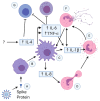The Many Faces of Innate Immunity in SARS-CoV-2 Infection
- PMID: 34199761
- PMCID: PMC8228170
- DOI: 10.3390/vaccines9060596
The Many Faces of Innate Immunity in SARS-CoV-2 Infection
Abstract
The innate immune system is important for initial antiviral response. SARS-CoV-2 can result in overactivity or suppression of the innate immune system. A dysregulated immune response is associated with poor outcomes; with patients having significant Neutrophil-to-Lymphocyte ratios (NLR) due to neutrophilia alongside lymphopenia. Elevated interleukin (IL)-6 and IL-8 leads to overactivity and is a prominent feature of severe COVID-19 patients. IL-6 can result in lymphopenia; where COVID-19 patients typically have significantly altered lymphocyte subsets. IL-8 attracts neutrophils; which may play a significant role in lung tissue damage with the formation of neutrophil extracellular traps leading to cytokine storm or acute respiratory distress syndrome. Several factors like pre-existing co-morbidities, genetic risks, viral pathogenicity, and therapeutic efficacy act as important modifiers of SARS-CoV-2 risks for disease through an interplay with innate host inflammatory responses. In this review, we discuss the role of the innate immune system at play with other important modifiers in SARS-CoV-2 infection.
Keywords: COVID-19; SARS-CoV-2; cytokines; innate immunity.
Conflict of interest statement
The authors declare that the review was conducted in the absence of any commercial or financial relationships that could be construed as a potential conflict of interest.
Figures


References
-
- World Health Organization WHO Coronavirus Disease (COVID-19) Dashboard. [(accessed on 2 June 2021)]; Available online: https://covid19.who.int.
Publication types
LinkOut - more resources
Full Text Sources
Miscellaneous

